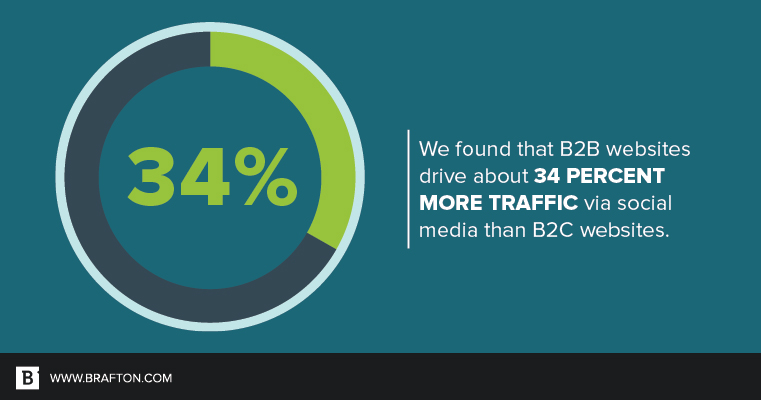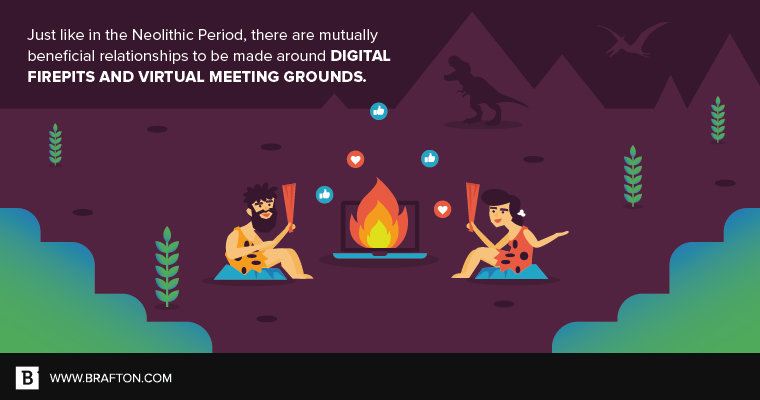Humans are social creatures because they need to be.
Our hominid ancestors learned quickly that they could share food, care for their young and fend off predators and rival tribes more effectively in social groups. We haven’t changed much for several millennia in this regard.
But we have vastly expanded our social reach and the size of our communities with online social networking.
And just like in neolithic times, there are mutually beneficial relationships to be made around these digital firepits and meeting grounds – hence social’s utility as a prominent channel in facilitating business-to-business partnerships.
Spark the right conversations with the right people, and you’ll build new business relationships.
Case in point:
On average, 5.85 percent of all B2B web traffic comes in through social media.
Surprisingly, this is more than in B2C, where social drives 4.35 percent of traffic. Some additional number-crunching led us to kind of a big realization:

One would think that consumer-facing social content would outperform B2B content, seeing as platforms such as Facebook and to a lesser extent, Twitter, use algorithms that favor people and events over businesses.
And yet it’s just the opposite.
Why the discrepancy?
Well, B2B social speaks to a very mindful audience.
While the consumer is more likely to lap water from the firehose of social media at random, the business-minded social user is very deliberate in his or her choice to engage with certain types of content, sponsored or otherwise. They want to know: “Does the conversation resonate with my business, its values and its current priorities?”
B2B social therefore demands greater precision than B2C since business users have such specific, nuanced needs and interests.
For example, everyone wears shoes, but not everyone is a 35 to 40-year-old IT manager at a small financial firm seeking a new disaster recovery plan.
By the numbers, these distinctions make B2B a slightly less random game to play. But they don’t make it any easier to win at.

While the general target audience may be easier to isolate, you can’t just throw social content at the wall (on the wall?) and see what sticks. Every one of those 140 characters (now 280) needs to be carefully chosen, because again, business users will be very selective about what they choose to click on, let alone share or like.
Not to mention, the content at the other end of organic social conversations, paid ads and sponsored links also needs to be memorable enough to keep leads in the funnel (we’ll come back to this point in just a bit).
With all of that in mind, research shows that business users are clicking, and in many cases sharing and liking, too.
More importantly, though, they’re basing their buying decisions on social content.
According to IDC, 84 percent of C-level buyers use social media to help make purchasing decisions.
It begs the question …
How is your ‘social’ life?
If you’re not entirely sure, start simple.
Use Google Analytics to find out how many people are coming to your site, and what percentage of those people are coming through social channels – LinkedIn, Twitter, Facebook, Pinterest, etc. Ideally, it should be at least 5 percent – hopefully more if you want to really distinguish your social presence from the pack.
Engagement (likes, retweets, shares, comments) and impressions (how many eyes are on this post) are also important metrics. They validate that you’re starting conversations worth having. To a lesser extent, you also want a solid follower base.
Generally speaking, the more the merrier, but you should really be thinking more about the precision of your message and what sort of brand personality is going into social discussions on your channels.
Attracting the right crowd is better than attracting the biggest crowd. Put another way, not all press is good press.

With paid social (ads, links to sponsored content), the goal should be to approximate your ROI. This requires the attachment of a UTM code to a custom URL, which is a function that can be enabled through Google Analytics. Essentially, this lets you track what traffic has come in through that paid social content, and specifically which channels those users are trickling in from.
But again, that Holy-Grail metric is website engagement.
Is your social strategy bringing traffic to your website? From there, ask what those users are doing when they get there.
Are they bouncing, or are they sticking around? How many pages are they viewing? Are they even really people?
Those are the types of metrics that will show whether or not your efforts are paying off.
And if they’re not paying off?
Figure out why.
Perform an audit to identify all of the efforts you’ve made so far, and which have yielded the best results.
Take stock of your campaigns – see which channels are highest performing, and determine if those results are being generated through organic or paid content.
But most importantly – and perhaps one of the easiest things to overlook, according to Erin Hancock, one of Brafton’s many social media mavens – is to actually have good content to promote at a steady cadence.
Build up your website. Offer ungated collateral and thought leadership. Show the audience something that will make them want to spend more time on your page, or at least come back every so often, to keep your brand top of mind.
“Have fun with it,” Hancock says. “This is your brand’s chance to make human connections that will drive business conversations.”
Finally, remember it’s called social media, so be social. Start conversations with other industry players on Facebook. Live-tweet from industry events. Share compelling Pulse content on LinkedIn.
All the while, make sure you write how you think your brand would talk if it had a mouth. You’re having a conversation at a business casual kickback, not soliloquizing at Carnegie Hall.
“Have fun with it,” Hancock says. “This is your brand’s chance to make human connections that will drive business conversations.”
So from one B to another B: Be social, be human, be smart, and you’ll be seen.





